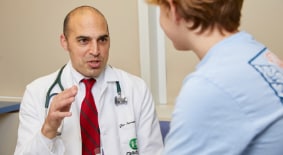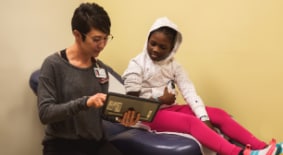Heart failure is a medical condition in which the heart does not squeeze or relax normally, and is unable to pump enough blood to deliver oxygen to meet the needs of the body. Heart failure can occur in infants, children and teens, and can be caused by many different forms of heart disease that affect heart function. It can occur gradually over time, but can also occur suddenly if there is a rapid decline in heart function.
Heart conditions that can cause heart failure:
- Cardiomyopathy: These are disorders or diseases of the heart muscle that reduce its ability to pump blood effectively. Cardiomyopathy can be present at birth (congenital), or can be caused by other medical conditions or diseases (acquired).
- Congenital Heart Defects: Also known as congenital heart disease or CHDs, these are birth defects that affect the structure of the heart, in which the heart chambers and connections are not formed normally. This can result in stress and damage to the heart muscle, affecting the heart’s function.
- Myocarditis: Infections or inflammatory disorders that can cause injury to the heart muscle.
- Cardiotoxicity: A heart muscle injury that is caused by other medications or treatments, such as chemotherapy or radiation therapy.
What are the signs and symptoms of heart failure?
Heart failure can result in a wide variety of symptoms and it typically occurs in stages based on the cause and severity of symptoms. Advanced heart failure is a more severe stage, and has more frequent and critical symptoms.
Symptoms of heart failure may include:
- Feeding difficulties: Infants and children may have difficulty feeding or may be unable to gain weight at a normal rate.
- Difficulty breathing: Rapid breathing, shortness of breath or labored breathing, especially during feeding or activity.
- Fatigue or exercise intolerance: Children may tire easily during exercise or activity or have decreased energy levels.
- Arrhythmias or abnormal heart rhythms: Children may have an abnormally fast (tachycardia) or abnormally slow (bradycardia) heart rate.
- Swelling: May occur in the legs, feet or ankles due to fluid buildup.
How is Heart Failure Diagnosed?
Patients showing signs of heart failure are typically referred to a pediatric cardiologist for diagnosis. Diagnosis of heart failure involves a comprehensive evaluation, including medical history, physical examination, heart imaging tests (echocardiography, cardiac MRI) and blood tests. Hemodynamic monitoring, a test that checks your child’s blood circulation and evaluates heart function, may be needed in some cases.
The Advanced Cardiac Therapies Program at the Children’s Heart Center is a collaboration between our Heart Failure and Cardiomyopathy Program, Ventricular Assist Device Program and Heart Transplant Program. Our program is certified by the Children's Cardiomyopathy Foundation, and brings together a multidisciplinary team of pediatric cardiologists, electrophysiologists, cardiothoracic surgeons, cardiac nurses and cardiac advanced practice providers who work together to diagnose, treat and manage heart failure in children, infants and teens, personalizing care based on their unique needs. Patients are seen by all necessary medical specialists, and are guided through treatments, which may include a combination of medical therapies, pacemaker implantation and implantable cardiac defibrillator (ICD) implantation. For children with end-stage heart failure, we offer advanced treatments including ventricular assist device placement and heart transplantation.
Why Choose the Advanced Cardiac Therapies Program at the Children’s Heart Center?
Excellent surgical outcomes
Cardiothoracic surgeons at the Children’s Heart Center perform hundreds of heart surgeries annually, with excellent survival rates, while performing some of the most complex procedures.
Family-centered care
We offer a variety of educational resources to inform families and empower them to partner with us in their child’s care.
Innovative research
Our researchers are seeking new ways to prevent, diagnose and treat the heart conditions that can lead to transplantation, in addition to investigating new transplantation-related techniques.
A Spotlight on Our Pediatric Heart Specialties
A ventricular assist device (VAD), is a mechanical pump that helps the heart function and maintain blood flow in children and teens who have heart failure. The device helps pump blood from the lower chambers of the heart to the vital organs, just as a healthy heart would.
VADs may be used as a treatment for your child:
- If they are waiting for a heart transplant.
- To help make them stronger and a better candidate for heart transplantation.
- During or after heart surgery until the heart recovers and functions as normal.
- If they are not a suitable candidate for a heart transplant.
The highly specialized team at the Children’s Heart Center has expertise in the placement and management of VADs, and will help choose the VAD that is the best treatment for your child’s condition. About one third of our patients receiving heart transplants are supported with a VAD prior to their transplantation.
- ECMO, or extracorporeal membrane oxygenation, uses heart and lung bypass machines to assume a patient’s heart and lung functions, allowing blood and oxygen to flow to the body adequately, while the heart and lungs heal.
- Impella devices are catheter-based heart pumps inserted in the cardiac catheterization lab that can support the heart function until recovery or longer-term treatments can be planned.
- PediMag and CentriMag are surgically implanted continuous-flow pumps that sit outside the body and help augment heart pumping until recovery or conversion to another pump, like the Berlin Heart EXCOR.
- The Berlin Heart EXCOR is a surgically implanted pulsatile pump that sits outside the body and helps critically ill children waiting for a transplant. One or two Berlin Heart pumps can be used to efficiently support one or both pumping chambers of the heart. This allows the child to come off the ventilator, eat on their own, walk around and undergo physical therapy, which helps them become a stronger candidate for a transplant when a donor heart arrives. Kids and teens must stay in the hospital while this VAD is in place.
- Heartmate 3 is a surgically implanted continuous-flow pump that is placed inside the body with a small driveline cable exiting the body that connects to a controller and power source. This device, designed for larger children and adults, can support heart function until a heart transplant or can be used as destination therapy. Children with this device can return home and go to school while waiting for a heart transplant.
- Jarvik 2015 is a small, surgically implanted continuous-flow pump designed for our smallest children. Jarvik 2015 is a small, surgically implanted continuous-flow pump designed for our smallest children. Like the Heartmate 3, this pump is placed inside the body with a small driveline cable exiting the body that connects to a controller and power source. This device is currently undergoing an investigational trial sponsored by the National Institutes of Health (NIH) and is available to select patients at Children’s.
Thriving After a Heart Transplant
When Kalani was diagnosed with cardiomyopathy, she was placed on the transplant list to receive a new heart.
watch her storyOur Heart Center is home to one of the largest pediatric heart transplant programs in the country, which helps ensure your child has access to an experienced team of heart surgeons and transplant specialists. Historically, our Heart Transplant Program has had shorter wait times for donor hearts than the national average, and since the program’s inception in 1988, we have performed nearly 450 heart transplants, making us one of the busiest heart transplant programs in the nation.** We deliver excellent outcomes, one- and three-year heart transplant survival rates that surpass the national average.
Children may need a heart transplant because of end-stage advanced heart failure or severe heart problems, such as:
- Inoperable complex congenital heart disease.
- Congenital heart disease that has failed surgical management.
- Symptomatic heart disease.
- Significant, uncontrollable rhythm abnormalities.
- Heart disease causing potentially irreversible damage to other organs.
How do I get my child on the transplant waitlist?
Before your child is approved for a pediatric heart transplant, they will undergo a transplant evaluation—a series of tests that may include a routine medical exam, blood tests, imaging tests, breathing tests and other evaluations in addition to extensive conversations with many members of the transplant team regarding the risks and benefits of transplantation.
If the child, family and heart transplant team decide that a pediatric heart transplant is the right treatment for your child, the next step is to place the child on the national waitlist for a donor heart.
United Network for Organ Sharing (UNOS) is the national agency that oversees organ transplantation. This agency works with our local procurement agency, LifeLink of Georgia, to recover organs. UNOS also maintains the national computerized list of people waiting for heart transplants.
How do the heart transplant waitlist and heart transplant donor processes work?
Once a decision has been made to move forward with a heart transplant, the heart transplant coordinator will place the child on the heart transplant waitlist through the secure UNOS website. The child will be listed as status 1A, status 1B, status 2 or status 7.
Status 1A: The patient must meet at least one of the following conditions:
- Needs help breathing with a ventilator.
- Needs support with a mechanical device such as ECMO or a ventricular assist device.
- Has ductal dependent pulmonary or systemic circulation requiring ductal stenting or continuous prostaglandins (PGE).
- Needs certain IV medications, known as inotropes, at a high dose; has congenital heart disease; and requires inpatient support.
- Is expected to live less than 14 days without a heart transplant.
Status 1B: The patient does not meet criteria for status 1A and must meet at least one of the following conditions:
- Needs IV medicine, known as inotropes, at a high dose without congenital heart disease.
- Has hypertrophic cardiomyopathy or restrictive cardiomyopathy and is younger than 12 months of age at time of listing.
Status 2: A patient requires a heart transplant but does not meet the criteria for statuses 1A or 1B.
Status 7: A patient is temporarily inactive on the transplant list. For example, the patient is too sick or too healthy to accept an organ.
The heart transplant donor process begins when a heart is donated from someone who has been declared brain-dead and whose family has agreed to organ donation. The donor’s medical information is entered into the UNOS database, and UNOS will notify Children’s that a heart is available. The transplant surgeon and team determine whether to accept or decline the organ—this is based on whether or not the heart is a good match for your child. The transplant coordinator will contact you when a heart that is a good match for your child is available.
How does the heart transplant patient-matching process work?
The UNOS waitlist has a pool of patients who are waiting for a heart donation. When a heart is available, UNOS searches the entire pool for a potential match.
Factors involved with matching include:
- Location of the heart and the child.
- The amount of time the child has been on the waiting list.
- Size of the child.
- Status of the child.
- Blood type: Your child can receive a heart from someone with the same or compatible blood type. Some children, especially infants, may be eligible to receive a heart from someone with any blood type due to their immature immune systems.
Visit the UNOS website for more information on the matching process.
What can I learn about the heart transplant donor?
Families often want to know the age of the donor and how the donor died. Information about the donor cannot be shared. Likewise, information about the heart transplant recipient and their family will not be given to the donor’s family without consent.
LifeLink will contact the donor family to let them know which organs were successfully transplanted. If the transplant recipient’s family gives permission, we will give LifeLink a small amount of nonidentifying information about the recipient, as LifeLink strongly believes that following up helps the donor family move forward as they grieve the death of their child.
If a recipient’s family wishes to, they can write a letter to the donor’s family that does not include identifying information. The Children’s heart transplant coordinator will send the letter to LifeLink of Georgia, which will forward it to the donor family.
A Top Heart Transplant Program in the Southeast
-
400th Heart Transplant at the Children's Heart Center
The Children’s Heart Center performs more pediatric heart transplants than any other pediatric hospital in the Southeast with excellent 1-year and 3-year survival rates.
At Children’s, we understand that a heart transplant is a long-term journey for your child, and we will guide you each step of the way. Children who undergo a heart transplant will require follow-up visits with a pediatric transplant cardiologist to monitor their progress, and will undergo frequent testing to monitor heart health. Your child will start regular, guided exercise in the hospital and should keep doing this at home to gradually increase their strength and endurance. Additionally, they will need to take medication for the rest of their life to help prevent the body from rejecting the new heart.
Support Services
We know that having a child in the hospital can be a stressful and difficult time. To help you navigate the emotional, financial, familial and spiritual challenges, we have a dedicated team that includes:
- Chaplains
- Child life specialists
- Family experience liaisons
- Financial services
- Kids at Heart
- Social workers
- Psychologists
At the Children’s Heart Center, our advanced cardiac therapies team is dedicated to the well-being and care of children of all ages—from birth to 21—who have been diagnosed with heart failure.
Cardiothoracic surgeons
- Paul Chai, MD, Co-Chief, Heart Center; Chief, Cardiothoracic Surgery
- Fawwaz Shaw, MD, Surgical Director, Advanced Cardiac Therapies Program
- Joshua Rosenblum, MD, PhD
- Subhadra Shashidharan, MD
- Mohan John, MD
Cardiologists
- William Mahle, MD, Co-Chief, Heart Center
- Chad Mao, MD, Medical Director, Advanced Cardiac Therapies Program
- Arene Butto, MD, MSc, Medical Director, Ventricular Assist Device Program
- Simran Jandu, MD, MHS
Nurse Practitioners
- Katie A. Berkowitz, RN, MSN, CPNP-AC
- Charissa Deckelmann, MSN, CPNP-AC/PC
- Diane Long, DNP, APRN, CPNP-AC/PC
- Diane Storie Perryman, MSN, CPNP-AC, PC
- Brittany Scoville, APRN, CPNP-AC
Psychologist
Transplant surgeries and pre- and post-transplant clinic visits are held at Arthur M. Blank Hospital.
Arthur M. Blank Hospital
2220 North Druid Hills Road NE
Atlanta, GA 30329
404-785-6476
Outpatient Pediatric Cardiology Locations
Children’s Cardiology sees patients at more than 20 outpatient locations throughout Georgia.
View outpatient cardiology clinic locations >
Call 404-246-2593 or complete a form to schedule an appointment >
Learn About Common Heart Conditions in Kids
*No. 14 on the U.S. News & World Report “Best Children’s Hospitals” list for 2025-26.
**The Scientific Registry of Transplant Recipients (SRTR).
Contact Us 404-785-6395







